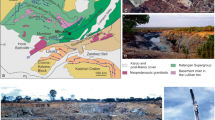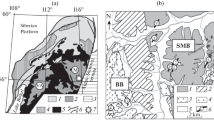Abstract
The Ketilidian Mobile Belt (KMB) in South Greenland is dominated by the Palaeoproterozoic Julianehåb Batholith (1,850–1,770 Ma) and is bordered by supracrustal sequences. The batholith is composed of granite, granodiorite, tonalite, diorite and subordinate gabbro and appinite and formed in a juvenile magmatic arc. The supracrustal rocks consist of psammites, pelites and subordinate, interstratified mafic volcanic rocks. A Rapakivi granite suite (1,755–1,735 Ma) intrudes them. Gold is an important metal in the KMB and occurs in various settings and element associations. Here, emphasis is placed on the Kangerluluk Cu–Au mineralization in the eastern part of the mobile belt. It is hosted within a remnant supracrustal succession dominated by redundant pillowed basalts. Structurally, a syn-volcanic association with gold can be distinguished from one that is clearly related to crosscutting quartz veins. In between, calc-silicate formation in the volcanic rocks occurred contemporaneously with a pervasive sericitization (bleaching) of leucocratic granitoids that are intrusive into the volcanic sequence. Bulk rock and mineral (sulfide) Pb isotope data are comparable in the Pb isotope space. The data define two groups of mineralization where one group is characterized by relatively higher 207Pb/204Pb at given 206Pb/204Pb ratios than the other. Pb stepwise leaching (PbSL) dating experiments performed on garnet and epidote associated with both groups of mineralization confirm the offset in the Pb isotope data. With the geochronological information from PbSL, the results indicate: (1) the initial gold mineralization was genetically related to metalliferous fluids associated with the emplacement of late intrusive stages of the Julianehåb Batholith (1,800–1,770 Ma); and (2) local remobilization of the initial mineralization (1,700–1,750) involved a Pb isotopically evolved fluid, which tentatively can be correlated with the intrusion of the Rapakivi granites in the area. Radiogenic Pb was not only found in altered host rocks but also in various sulfides, suggesting that fluids may have percolated through and/or originated from uranium-bearing graphitic schists which are abundant in the sedimentary package of the KMB. Lead isotopic results suggest that the Rapakivi granites may have supplied heat for renewed circulation of fluids within the supracrustal rock pile.
Similar content being viewed by others
Author information
Authors and Affiliations
Additional information
Received: 27 November 1999 / Accepted: 22 November 2000
Rights and permissions
About this article
Cite this article
Stendal, H., Frei, R., Hamilton, M. et al. The Palaeoproterozoic Kangerluluk gold–copper mineralization (southeast Greenland): Pb and Nd isotopic constraints on its timing and genesis. Mineral. Deposita 36, 177–188 (2001). https://doi.org/10.1007/s001260050297
Issue Date:
DOI: https://doi.org/10.1007/s001260050297




